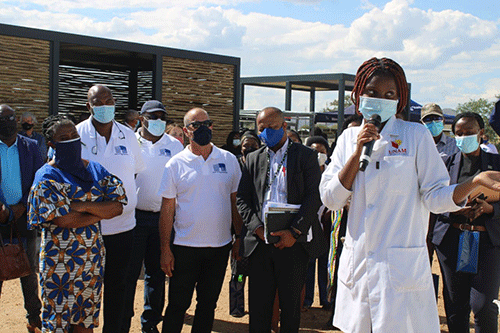Maihapa Ndjavera
Standard Bank and the Massachusetts Institute of Technology (MIT)’s Centre for Bits and Atoms, and US-based architecture firm Redhouse studio, have partnered on a local innovative social upliftment project that uses fungal material from mushrooms to develop both housing and food products. Outgoing Standard Bank CEO Vetumbuavi Mungunda said at the BioHab site visit last week that the aim is to grow nutritious food and affordable housing materials from mushroom mycelium.
“The process uses waste materials to create food, jobs and shelter. In Namibia, the project will use the indigenous encroacher bush that is choking essential natural water aquifers, wildlife and cattle grazing lands,” he explained.
The bush is harvested to create substrate (food) for mushroom farming. Gourmet, nutritious mushrooms are grown and harvested, and the resulting material left behind is compacted into sustainable eco-friendly building materials.
Mungunda said buildings made with these materials could be market-related or in the form of affordable housing, refugee shelters, school rooms or community halls. The project has already started putting mushrooms on Spar shelves, and these are doing well on the market.
In collaboration with the Shack Dwellers Federation of Namibia, Standard Bank launched its Buy-a-Brick initiative in October 2015, and over 600 houses have been built across the country since inception. In efforts to find materials that won’t be imported, they came up with building bricks from mushroom mycelium.
Mungunda further stated that Unam graduates handle the research and mushroom cultivating, processing and making bricks from the materials.
First Lady Monica Geingos said at the same occasion that this is an exciting initiative which provides affordable building materials for informal settlements. She added that the equation also touches on food security, environmental sustainability and job creation.
The First Lady applauded the designers of the project, referring to it as ‘revolutionary’ to be able to design a framework that allows for the disposal of encroaching bush into the creation of a viable food source through the production of mushroom, and then use the bi-product mycelium to create bricks.
“This project opens up so many applications, and most importantly, challenges the building industry and society to think differently about how we can solve problems by being creative in promoting the lives of every member of society,” noted Geingos.
“It’s important to always dream big,” she advised, recalling how this project was presented to her as an idealistic plan in 2018, and that this project serves as a perfect example of the magic that happens when the first and second economies collaborate to provide solutions.
She furthermore pointed out that approaches which understand that solutions must be community-driven are generally more sustainable. “Problems unique to the informal settlements cannot be resolved by using conventional ideas, processes, regulations or laws,” stressed Geingos.
-mndjavera@nepc.com.na


